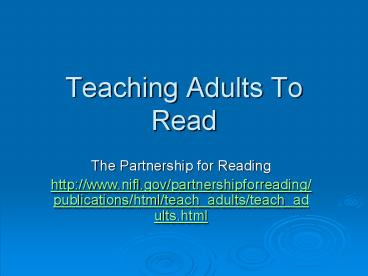Teaching Adults To Read - PowerPoint PPT Presentation
1 / 24
Title:
Teaching Adults To Read
Description:
Prosody. Reading with appropriate pausing and expression. Rate ... Instructional Level for rate and prosody highest grade level rated a '2' ... – PowerPoint PPT presentation
Number of Views:45
Avg rating:3.0/5.0
Title: Teaching Adults To Read
1
Teaching Adults To Read
- The Partnership for Reading
- http//www.nifl.gov/partnershipforreading/publicat
ions/html/teach_adults/teach_adults.html
2
Teaching Adults To Read
- Evidence-Based Reading Instruction
- Research
- Adult Learners Characteristics
3
Components of Reading
- Alphabetics
- Fluency
- Vocabulary
- Comprehension
4
Questions to Address
- What is the component?
- Why teach it?
- How do you assess it?
????? ?????
5
ALPHABETICS
- Phonemic Awareness
- sounds manipulation
- Word Analysis
- Connect letters and letter patterns with the
sounds - Sight Words
- irregularly spelled words
6
Assessing Alphabetics
- Graded Word Lists
Alphabetics Instruction
- Explicit Instruction
7
Fluency
- Accuracy
- Decoding words correctly
- Prosody
- Reading with appropriate pausing and expression
- Rate
- Fast enough to support comprehension and not too
fast that it hinders comprehension
8
Fluency Scale
9
Fluency Scale
- Mastery Level for Fluency highest grade level
of passage difficulty on which a student is rated
a 3. - Instructional Level for rate and prosody
highest grade level rated a 2. - Instructional Level for Accuracy is the highest
grade level rated a 1.
10
Vocabulary
- Meaning know and understand meanings
- Breadth how many words are known
- Depth how deeply we understand words
11
Assessing Vocabulary
- Oral Vocabulary Test measures general knowledge
of word meanings.
12
Comprehension
- Constructing Meaning From What is
Read
13
Assessing Comprehension
- Ask Students to Read and Answer
Questions
14
Ultimate Goal
- Comprehension
- People read to learn and understand.
15
Reading Profiles
- Creates a Picture of a Readers Strengths and
Needs for Instructional Purposes
16
Diagnostic Assessments
- One-on-one assessments
- Purpose determine strengths needs
- 35-40 minutes dont chat
- Get Organized
- Assess early on to determine instruction in the
classroom
17
BADER Diagnostic Reading Assessment
- Alphabetics
-
Student reads aloud words
from a graded word list until reaching ninth
grade - 70-90 correct
- Begin with TABE score
18
Diagnostic Reading Assessment
- Fluency
- Start at the alphabetics mastery level
- Student reads aloud graded passages until
reaching ninth grade OR the passages become too
difficult to continue - Fluency Scale Score
- Highest level rated 3 is Mastery
19
Diagnostic Reading Assessment
- Vocabulary
- Student is asked to give definition of Words
- Mastery Level
- Highest grade level where 75-80 of words defined
are correct
20
Diagnostic Reading Assessment
- Comprehension
- Student reads a graded passage silently and then
answers questions - Mastery Level
- Highest grade level at which at least 75 of
questions are answered correctly
21
Kims Reading Profile
- TABE Score 6.4
- Alphabetics (Word List) 8.0
- Fluency Mastery 6.0
- Rate Prosody Instructional 8.0
- Alphabetics Instructional 8.0
- Accuracy NA
- Vocabulary Mastery 4.0 Instructional 5.0
- Comprehension Mastery 4.0 Instructional 5.0
22
Kims Strengths and Needs
- Strengths
- Alphabetics
- Fluency is at 8.0
- Needs
- Vocabulary Instruction at 5.0
- Comprehension Instruction at 5.0
23
Other Suggestions
- Use adult oriented material
- Devote sufficient classroom time to reading and
writing instruction - Encourage students to spend more time in ABE
programs - Employ certified or experience teachers for ABE
instruction
24
Assignment
- Review Ben Readers Reading Assessment
- List his strengths
- List his needs
- Begin thinking about how you would help this
student in class - Trainers will show you the pieces of the BADER
assessment































